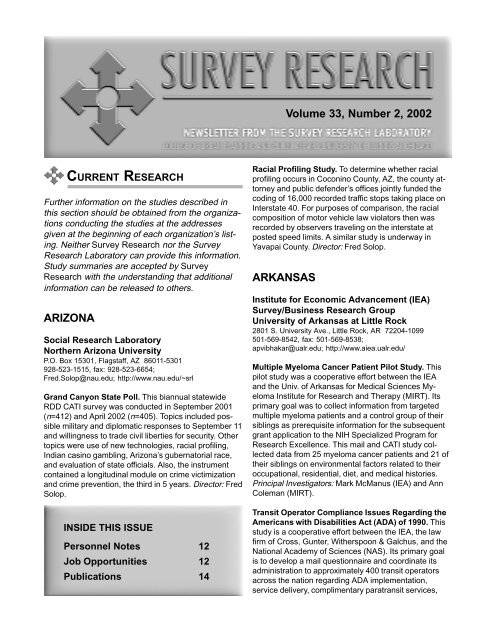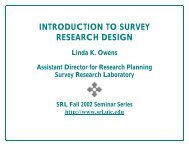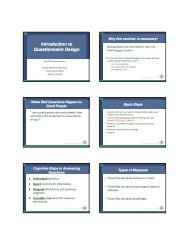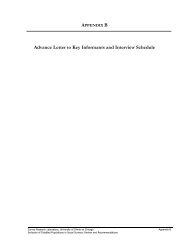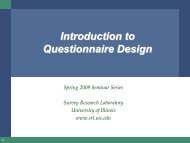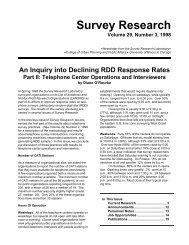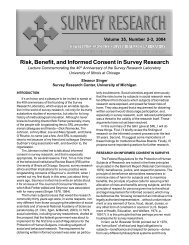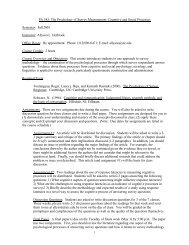No. 2 - Survey Research Laboratory - University of Illinois at Chicago
No. 2 - Survey Research Laboratory - University of Illinois at Chicago
No. 2 - Survey Research Laboratory - University of Illinois at Chicago
- No tags were found...
Create successful ePaper yourself
Turn your PDF publications into a flip-book with our unique Google optimized e-Paper software.
Volume 33, Number 2, 2002CURRENT RESEARCHFurther inform<strong>at</strong>ion on the studies described inthis section should be obtained from the organiz<strong>at</strong>ionsconducting the studies <strong>at</strong> the addressesgiven <strong>at</strong> the beginning <strong>of</strong> each organiz<strong>at</strong>ion’s listing.Neither <strong>Survey</strong> <strong>Research</strong> nor the <strong>Survey</strong><strong>Research</strong> <strong>Labor<strong>at</strong>ory</strong> can provide this inform<strong>at</strong>ion.Study summaries are accepted by <strong>Survey</strong><strong>Research</strong> with the understanding th<strong>at</strong> additionalinform<strong>at</strong>ion can be released to others.ARIZONASocial <strong>Research</strong> <strong>Labor<strong>at</strong>ory</strong><strong>No</strong>rthern Arizona <strong>University</strong>P.O. Box 15301, Flagstaff, AZ 86011-5301928-523-1515, fax: 928-523-6654;Fred.Solop@nau.edu; http://www.nau.edu/~srlGrand Canyon St<strong>at</strong>e Poll. This biannual st<strong>at</strong>ewideRDD CATI survey was conducted in September 2001(n=412) and April 2002 (n=405). Topics included possiblemilitary and diplom<strong>at</strong>ic responses to September 11and willingness to trade civil liberties for security. Othertopics were use <strong>of</strong> new technologies, racial pr<strong>of</strong>iling,Indian casino gambling, Arizona’s gubern<strong>at</strong>orial race,and evalu<strong>at</strong>ion <strong>of</strong> st<strong>at</strong>e <strong>of</strong>ficials. Also, the instrumentcontained a longitudinal module on crime victimiz<strong>at</strong>ionand crime prevention, the third in 5 years. Director: FredSolop.INSIDE THIS ISSUEPersonnel <strong>No</strong>tes 12Job Opportunities 12Public<strong>at</strong>ions 14Racial Pr<strong>of</strong>iling Study. To determine whether racialpr<strong>of</strong>iling occurs in Coconino County, AZ, the county <strong>at</strong>torneyand public defender’s <strong>of</strong>fices jointly funded thecoding <strong>of</strong> 16,000 recorded traffic stops taking place onInterst<strong>at</strong>e 40. For purposes <strong>of</strong> comparison, the racialcomposition <strong>of</strong> motor vehicle law viol<strong>at</strong>ors then wasrecorded by observers traveling on the interst<strong>at</strong>e <strong>at</strong>posted speed limits. A similar study is underway inYavapai County. Director: Fred Solop.ARKANSASInstitute for Economic Advancement (IEA)<strong>Survey</strong>/Business <strong>Research</strong> Group<strong>University</strong> <strong>of</strong> Arkansas <strong>at</strong> Little Rock2801 S. <strong>University</strong> Ave., Little Rock, AR 72204-1099501-569-8542, fax: 501-569-8538;apvibhakar@ualr.edu; http://www.aiea.ualr.edu/Multiple Myeloma Cancer P<strong>at</strong>ient Pilot Study. Thispilot study was a cooper<strong>at</strong>ive effort between the IEAand the Univ. <strong>of</strong> Arkansas for Medical Sciences MyelomaInstitute for <strong>Research</strong> and Therapy (MIRT). Itsprimary goal was to collect inform<strong>at</strong>ion from targetedmultiple myeloma p<strong>at</strong>ients and a control group <strong>of</strong> theirsiblings as prerequisite inform<strong>at</strong>ion for the subsequentgrant applic<strong>at</strong>ion to the NIH Specialized Program for<strong>Research</strong> Excellence. This mail and CATI study collectedd<strong>at</strong>a from 25 myeloma cancer p<strong>at</strong>ients and 21 <strong>of</strong>their siblings on environmental factors rel<strong>at</strong>ed to theiroccup<strong>at</strong>ional, residential, diet, and medical histories.Principal Investig<strong>at</strong>ors: Mark McManus (IEA) and AnnColeman (MIRT).Transit Oper<strong>at</strong>or Compliance Issues Regarding theAmericans with Disabilities Act (ADA) <strong>of</strong> 1990. Thisstudy is a cooper<strong>at</strong>ive effort between the IEA, the lawfirm <strong>of</strong> Cross, Gunter, Witherspoon & Galchus, and theN<strong>at</strong>ional Academy <strong>of</strong> Sciences (NAS). Its primary goalis to develop a mail questionnaire and coordin<strong>at</strong>e itsadministr<strong>at</strong>ion to approxim<strong>at</strong>ely 400 transit oper<strong>at</strong>orsacross the n<strong>at</strong>ion regarding ADA implement<strong>at</strong>ion,service delivery, complimentary par<strong>at</strong>ransit services,
MASSACHUSETTSCenter for <strong>Survey</strong> <strong>Research</strong><strong>University</strong> <strong>of</strong> Massachusetts Boston100 Morrissey Blvd., Boston, MA 02125-3393617-287-7200, fax: 617-287-7210;csr@umb.edu; http://www.csr.umb.eduResident Assessment <strong>of</strong> Pain Management. Thismethodological study aims to compare the answersobtained from nursing home residents about their experience<strong>of</strong> pain and pain medic<strong>at</strong>ions with the responsesobtained from proxy respondents. Analyses will focuson the ability <strong>of</strong> family members and close friends toaccur<strong>at</strong>ely report the resident’s experience <strong>of</strong> pain andthe nursing home’s management <strong>of</strong> the pain. The designcalls for 450 interviews: 150 paired interviews withcognitively intact nursing home respondents and theirproxies (300 interviews total), and 150 interviews withproxy respondents for cognitively impaired respondents.All p<strong>at</strong>ient interviews will be conducted face to face <strong>at</strong>the nursing home, while proxy interviews will have theoption <strong>of</strong> being completed over the telephone. The RobertWood Johnson Found<strong>at</strong>ion is providing funding.Study Director: Brian Clarridge.N<strong>at</strong>ional End <strong>of</strong> Life Care Study. This is the first <strong>of</strong>two planned d<strong>at</strong>a collections from a n<strong>at</strong>ional sample <strong>of</strong>de<strong>at</strong>h certific<strong>at</strong>e informants on the end <strong>of</strong> life care receivedby individuals before they died. The goal is toexamine differences in health care delivery practices byplace <strong>of</strong> de<strong>at</strong>h (hospital, nursing home, home), by geography,and by intervention practices (ICU use). D<strong>at</strong>acollection is designed to cover 25 st<strong>at</strong>es under a 2-stage probability sample design. The target is 1,300completed interviews: 800 randomly selected fromst<strong>at</strong>ewide d<strong>at</strong>a files, 250 from high medical interventionareas, and 250 from low medical intervention areas.The d<strong>at</strong>a collection concept and many <strong>of</strong> the proceduresclosely followed the N<strong>at</strong>ional Mortality FollowbackStudy <strong>of</strong> 1993. The study is funded by the Robert WoodJohnson Found<strong>at</strong>ion. Study Director: Brian Clarridge.Self Determined Life Closure. In collabor<strong>at</strong>ion with theN<strong>at</strong>ional Hospice and Palli<strong>at</strong>ive Care Organiz<strong>at</strong>ion, CSRis involved in the design <strong>of</strong> a questionnaire about lifeclosure. The goal is to obtain useful feedback fromdying individuals and their families about the importantsocial and health care domains th<strong>at</strong> determine thequality <strong>of</strong> an individual’s de<strong>at</strong>h. The questionnaire willbe capable <strong>of</strong> being administered by a hospice staffmember for a p<strong>at</strong>ient or family member and will consist<strong>of</strong> a rel<strong>at</strong>ively small number <strong>of</strong> questions. The study willinclude a field test covering 180 families in 3 testhospice facilities. D<strong>at</strong>a collection will be managed <strong>at</strong> thesepar<strong>at</strong>e loc<strong>at</strong>ions with d<strong>at</strong>a entry and analysis occurring<strong>at</strong> CSR. Study Director: Brian Clarridge.Surgical Volume M<strong>at</strong>ters: Helping P<strong>at</strong>ients PickHospitals. A n<strong>at</strong>ional telephone survey <strong>of</strong> Medicarebeneficiaries who have undergone recent surgery(N=600) will be conducted this year. The goals are tolearn how Medicare p<strong>at</strong>ients currently choose hospitalsfor high-risk surgery and to determine the extent <strong>of</strong>Medicare beneficiaries’ knowledge about volume andrisk. The project is funded by the Agency for Healthcare<strong>Research</strong> and Quality. Principal Investig<strong>at</strong>or: JohnBirkmeyer (Dartmouth Medical School), Study Director:P<strong>at</strong>ricia Gallagher.Organiz<strong>at</strong>ional Determinants <strong>of</strong> HIV Care Improvements.Sponsored by the Health Resources and ServicesAdministr<strong>at</strong>ion, a longitudinal mail survey <strong>of</strong> medicaldirectors and clinicians working <strong>at</strong> HIV/AIDS clinicsacross the U.S. was conducted to evalu<strong>at</strong>e a programdesigned to improve p<strong>at</strong>ient care. A total <strong>of</strong> 463 questionnairesfrom intervention and control sites were completed<strong>at</strong> baseline and 462 during the recently completedsecond wave <strong>of</strong> the survey. Principal Investig<strong>at</strong>or:Paul Cleary (Harvard Medical School), Study Directors:P<strong>at</strong>ricia Gallagher and Floyd Fowler, Jr.MICHIGAN<strong>Survey</strong> <strong>Research</strong> CenterInstitute for Social <strong>Research</strong><strong>University</strong> <strong>of</strong> MichiganP.O. Box 1248, Ann Arbor, MI 48106-1248734-764-8365, fax: 734-764-5193;srchr@isr.umich; http://www.isr.umich.eduFamily Form<strong>at</strong>ion, Context, and Well-Being: A Re-Interview. Funded by the N<strong>at</strong>ional Institute <strong>of</strong> MentalHealth, this study will re-interview the 3,400 respondentsfrom the first wave in 1995–96 who were sampledfrom 21 metropolitan areas across the U.S. The purposeis to provide a better understanding <strong>of</strong> the rel<strong>at</strong>ionshipbetween <strong>at</strong>titudes toward marriage and family and<strong>at</strong>titudes about race, ethnicity, religion, gender roles,and economic well-being. Principal Investig<strong>at</strong>or: BelindaTucker (UCLA), <strong>Survey</strong> Manager: Lloyd Hemingway.<strong>Survey</strong>s <strong>of</strong> Consumers. Begun in 1946, the <strong>Survey</strong>s<strong>of</strong> Consumers is the longest ongoing study <strong>of</strong> consumer<strong>at</strong>titudes and expect<strong>at</strong>ions. The survey has beenreplic<strong>at</strong>ed in this country as well as in 3 dozen othercountries and is based on a represent<strong>at</strong>ive sample <strong>of</strong> allU.S. households, with 500 telephone interviews conductedeach month. The historical d<strong>at</strong>a series areavailable <strong>at</strong> http://www.umich.edu/~umsurvey. ProjectDirector: Richard Curtin, <strong>Research</strong> Associ<strong>at</strong>e: RebeccaMcBee, <strong>Survey</strong> Manager: Michael Shrank, <strong>Research</strong>Technicians: Julia Locklear, Ann Munster, and BrennaMuldavin.<strong>Survey</strong> <strong>Research</strong> 4Number 2, 2002
Health and Retirement Study (HRS) 2002. Approxim<strong>at</strong>ely19,500 CAI interviews will be completed n<strong>at</strong>ionwidein Wave 6 <strong>of</strong> this study. The HRS was designed toprovide researchers, policy analysts and program managerswith reliable, current d<strong>at</strong>a on the economic andphysical well-being <strong>of</strong> Americans 50 and older. Also, itwas intended to furnish insight into how health andwealth interact with work, retirement, and family responsibilitiesover time to affect decision making. Mode <strong>of</strong>administr<strong>at</strong>ion is primarily telephone. Principal Investig<strong>at</strong>or:Robert Willis, <strong>Survey</strong> Director: Nicole Kirgis.MINNESOTAMinnesota Center for <strong>Survey</strong> <strong>Research</strong><strong>University</strong> <strong>of</strong> Minnesota2331 <strong>University</strong> Ave. S.E., Suite 141Minneapolis, MN 55414-3067612-627-4282, fax: 612-627-4288;armso001@umn.edu;http://www.cura.umn.edu/programs/mcsr.html2001 Minnesota St<strong>at</strong>e <strong>Survey</strong>. This was Part 2 <strong>of</strong> the18th annual omnibus survey <strong>of</strong> adults in Minnesota.From October 2001 to January 2002, RDD CATIinterviews were completed with 802 adults. The surveywas sponsored by government agencies and the Univ.<strong>of</strong> Minnesota and explored quality <strong>of</strong> life, technology,environment, housing, and the Univ. <strong>of</strong> Minnesota.Project Manager: Pam Jones, Study Director: RossanaArmson.2001 Twin Cities Area <strong>Survey</strong>. This was the 19th annualomnibus survey <strong>of</strong> adults residing in the 7-countyMinneapolis-St. Paul area. A total <strong>of</strong> 804 RDD CATIsurveys were completed between December 2001 andMarch 2002. The survey was sponsored by governmentagencies and the Univ. <strong>of</strong> Minnesota and included thefollowing nine topics: quality <strong>of</strong> life, transport<strong>at</strong>ion, nonpr<strong>of</strong>itsocial or human services, acceptable behavior,housing, environment, technology, higher educ<strong>at</strong>ion,and demographics. Project Manager: Pam Jones,Study Director: Rossana Armson.NEVADACenter for Applied <strong>Research</strong> (CAR)<strong>University</strong> <strong>of</strong> Nevada, RenoReno, NV 89557-0017775-784-6718, fax: 775-784-4506;calder@scs.unr.edu; http://sabcar.unr.eduAppropri<strong>at</strong>eness <strong>of</strong> Placement Level in SubstanceAbuse Tre<strong>at</strong>ment Programs. Using an in-person clinicaldiagnostic interview based on DSM-IV criteria, CARconducted CAPI interviews <strong>at</strong> Nevada tre<strong>at</strong>ment centerswith a randomly selected sample <strong>of</strong> clients receivingst<strong>at</strong>e-supported tre<strong>at</strong>ment in 6 <strong>of</strong> Nevada’s 15 counties.The purpose <strong>of</strong> the research was to compare actualtre<strong>at</strong>ment placement level decisions made by centerpersonnel for each client/p<strong>at</strong>ient against the results<strong>of</strong> CAR’s independent clinical interviews. D<strong>at</strong>a from the256 CAPI interviews were transl<strong>at</strong>ed into DSM-IV diagnosesusing an algorithm designed to produce scoresindic<strong>at</strong>ive <strong>of</strong> abuse or dependence for 7 core substances.The presence (or absence) <strong>of</strong> DSM-IV diagnosesfor abuse or dependence for each client thenwere transl<strong>at</strong>ed into an appropri<strong>at</strong>e tre<strong>at</strong>ment placementlevel using ASAM P<strong>at</strong>ient Placement Criteria(PPC-2). Funding for the research was provided by theCenter for Substance Abuse Tre<strong>at</strong>ment. Principal Investig<strong>at</strong>or:Judy Calder (CAR/Dept. <strong>of</strong> Human Dev. andFamily Studies), Project Managers: Paula Nichols-Rodriguez and Tyler Bee.The Economic Impact <strong>of</strong> TANF Payments. This is alongitudinal study <strong>of</strong> the economic impact <strong>of</strong> monthlyTANF payments on recipients and on those who residein each recipient’s household. In addition to measurement<strong>of</strong> basic demographic variables, changes inhousehold composition, employment st<strong>at</strong>us, totalmonthly household income, and a variety <strong>of</strong> othermeasures <strong>of</strong> economic and psychosocial adjustmentfactors are being examined using a “change over time”paradigm. D<strong>at</strong>a collection, which recently has beencompleted, has been ongoing for 2 years using electronicallyscannable mail-out questionnaires, reminderpost-cards, and CATI interviews, with all <strong>of</strong> the foregoingsupported by incentive payments for respondents.Each TANF recipient was surveyed during the firstmonth <strong>of</strong> receipt <strong>of</strong> TANF payment and then wasfollowed up <strong>at</strong> 3-, 6-, 9-, 12-, 18-, and 24-month intervals,with a new wave <strong>of</strong> sample <strong>of</strong> approxim<strong>at</strong>ely 200recipients added each month. The Social SecurityAdministr<strong>at</strong>ion provided funding. Principal Investig<strong>at</strong>ors:Judy Calder (CAR) and Dick Bartholet (College <strong>of</strong>Business Administr<strong>at</strong>ion, UNR), Project Managers:K<strong>at</strong>hy Imasaki, Michiko Okura, and Betty Foerster.Child Care Work Force Study. Designed as a census<strong>of</strong> the entire Nevada childcare workforce, this researchsurveyed 426 directors/owners <strong>of</strong> licensed child carecenters, 5,339 teachers/child care providers in theselicensed centers, 607 licensed homecare providers, 450unlicensed homecare providers, a random sample <strong>of</strong>parents whose children are receiving child care, as wellas licensure agency personnel. A separ<strong>at</strong>e on-siteobserv<strong>at</strong>ion paradigm was developed to assess thequality <strong>of</strong> childcare using standardized instruments. Thestudy objectives included the following: (1) establish ast<strong>at</strong>ewide directory <strong>of</strong> the child care work force inNevada; (2) characterize the st<strong>at</strong>us <strong>of</strong> current wagesNumber 2, 20025 <strong>Survey</strong> <strong>Research</strong>
<strong>Survey</strong> <strong>Research</strong> Soliciting Lead Articles forUpcoming IssuesThe <strong>Survey</strong> <strong>Research</strong> newsletter is extending an invit<strong>at</strong>ion to those in thesurvey research field to submit original work on topics <strong>of</strong> interest to the surveyresearch community—such as methods for reducing nonresponse, experiencewith Web surveys, and str<strong>at</strong>egies for recruiting and retaining interviewers—forinclusion in an upcoming issue. Submissions should be between 750 and1,500 words and can be sent to krish@srl.uic.edu.and working conditions <strong>of</strong> child care providers, includinga demographic pr<strong>of</strong>ile <strong>of</strong> child care providers themselves;and (3) provide specific recommend<strong>at</strong>ions to theNevada legisl<strong>at</strong>ure with regard to improvement <strong>of</strong> theavailability and quality <strong>of</strong> child care in Nevada. TheSocial Security Administr<strong>at</strong>ion provided funding. PrincipalInvestig<strong>at</strong>ors: Eva Essa (Dept. <strong>of</strong> Human Developmentand Family Studies, UNR) and Judy Calder (CAR/Dept. <strong>of</strong> Human Dev. and Family Studies), ProjectManager: Kimberly Barr.Estim<strong>at</strong>ing Substance Abuse and Tre<strong>at</strong>ment Needin Rural Nevada. This was an optimized RDD CATIsurvey <strong>of</strong> adults in rural Nevada counties designed toassess met and unmet demand for substance abusetre<strong>at</strong>ment for alcohol and other drugs and was completedin April 2002. D<strong>at</strong>a collection on this survey <strong>of</strong>1,399 adults was conducted using funding provided bythe Center for Substance Abuse Tre<strong>at</strong>ment. Theprevalence <strong>of</strong> abuse and dependence for alcohol andother drugs was measured using a CATI-based clinicalinterview, the results <strong>of</strong> which were scored to producethe prevalence <strong>of</strong> diagnoses <strong>of</strong> abuse or dependencefor each <strong>of</strong> seven substances separ<strong>at</strong>ely, using DSM-IVcriteria. Those interviewed were asked about their use<strong>of</strong> alcohol and 6 other substances, previous tre<strong>at</strong>menthistory, employment, insurance st<strong>at</strong>us, a wide variety <strong>of</strong>demographic descriptors, access to tre<strong>at</strong>ment andperceived need for tre<strong>at</strong>ment, and measures <strong>of</strong> psychosocialadjustment. Principal Investig<strong>at</strong>or: Judy Calder(CAR/Dept. <strong>of</strong> Human Dev. and Family Studies),Project Managers: K<strong>at</strong>hy Imasaki and Tyler Bee.NEW HAMPSHIRE<strong>Survey</strong> Center<strong>University</strong> <strong>of</strong> New HampshireThompson Hall, 105 Main St., Durham, NH 03824603-862-2226, fax: 603-862-1488;Andrew.Smith@unh.edu;http://www.unh.edu/ipssr/survey-center/Granite St<strong>at</strong>e Poll, April 2002. The <strong>Survey</strong> Centerconducted CATI interviews with 694 New Hampshireadults between April 10 and April 18, 2002. The GraniteSt<strong>at</strong>e Poll is a quarterly survey <strong>of</strong> public opinion in NewHampshire and is conducted to determine present<strong>at</strong>titudes concerning the New Hampshire politicalenvironment, public policy, and consumer confidence inthe st<strong>at</strong>e. Principal Investig<strong>at</strong>or: Andrew Smith.Biosolids <strong>Survey</strong>. This n<strong>at</strong>ionwide CATI survey <strong>of</strong>1,069 adults was conducted between February 15 andMarch 15, 2002, for the Center <strong>of</strong> Environmental Communic<strong>at</strong>ions.The purpose <strong>of</strong> the survey was to assessknowledge and <strong>at</strong>titudes about the use <strong>of</strong> biosolids.Principal Investig<strong>at</strong>or: Andrew Smith.New Hampshire Women’s Business <strong>Survey</strong>. Approxim<strong>at</strong>ely400 female business owners or CEOs in NewHampshire were interviewed in May 2002. The purpose<strong>of</strong> the CATI study was to identify barriers to the cre<strong>at</strong>ionand growth <strong>of</strong> women-owned businesses. Principal Investig<strong>at</strong>or:Andrew Smith.<strong>Survey</strong> <strong>Research</strong> 6Number 2, 2002
NORTH CAROLINASocial and St<strong>at</strong>istical Sciences<strong>Research</strong> Triangle Institute3040 Cornwallis Road, P.O. Box 12194<strong>Research</strong> Triangle Park, NC 27709-2194919-541-7008, fax: 919-541-7004;rak@rti.org; http://www.rti.orgIntegr<strong>at</strong>ed Postsecondary Educ<strong>at</strong>ion D<strong>at</strong>a System(IPEDS). IPEDS is a single, comprehensive systembuilt around a series <strong>of</strong> interrel<strong>at</strong>ed surveys designed tocollect institution-level d<strong>at</strong>a on institution characteristics,enrollment, program completion, faculty, staff, finances,and gradu<strong>at</strong>ion r<strong>at</strong>es from 6,636 Title IV institutions. Infall 2000, the Web-based system replaced the paperquestionnaires previously used for this ongoing d<strong>at</strong>acollection. Project Director: Janice Kelly.Educ<strong>at</strong>ion Longitudinal Study <strong>of</strong> 2002. Sponsored bythe N<strong>at</strong>ional Center for Educ<strong>at</strong>ion St<strong>at</strong>istics, this studyexamines the rel<strong>at</strong>ionship between early high schoolexperiences and experiences in postsecondary educ<strong>at</strong>ionand the work force. Group administr<strong>at</strong>ion <strong>of</strong> studentquestionnaires and cognitive tests in m<strong>at</strong>h and readingwere conducted with approxim<strong>at</strong>ely 20,000 tenth gradestudents in about 800 schools across the n<strong>at</strong>ion betweenJanuary and May 2002. Questionnaires also arebeing mailed to those students’ m<strong>at</strong>h and Englishteachers, the students’ parents, and school administr<strong>at</strong>orsand library media center coordin<strong>at</strong>ors <strong>at</strong> eachschool. <strong>No</strong>nresponse follow-up for students and parentswill be conducted with CATI technology. The students’transcripts will be collected in 2 years. Project Director:Dan Pr<strong>at</strong>t, Principal Investig<strong>at</strong>or: Steven Ingels, Associ<strong>at</strong>eProject Director: Ellen Stutts.OHIO<strong>Survey</strong> <strong>Research</strong> <strong>Labor<strong>at</strong>ory</strong>Kent St<strong>at</strong>e <strong>University</strong> (KSU)227 Merrill Hall, Kent, OH 44242-0001330-672-2562, fax: 330-672-4724;bmcdonal@kent.edu; http://www.kent.edu/c<strong>at</strong>iAnnual Community Health Evalu<strong>at</strong>ion <strong>Survey</strong>(ACHES 2002). One thousand CATI interviews will becompleted this year, including an oversample <strong>of</strong> lowincomeand elderly popul<strong>at</strong>ions. Topics concern thehealth and well-being <strong>of</strong> residents in <strong>No</strong>rtheast Ohio,neighborhood perceptions, and September 11. This isthe fourth year d<strong>at</strong>a has been collected for this studyfunded by the Sociology Dept. Principal Investig<strong>at</strong>ors: T.Gallagher, R. Johnson, A. Kroska, A. London, K.Marcussen, C. Ritter, S. Roxburgh, and S. Wilcox,Project Manager: Brian McDonald.Problem Drinking Among African American Workers.This is the second wave <strong>of</strong> CATI interviews following2,247 interviews completed a year ago by KSU, theUniv. <strong>of</strong> Georgia, and Indiana Univ. The project is examiningalcohol use among African Americans and isfunded by the N<strong>at</strong>ional Institute on Alcohol Abuse andAlcoholism. Principal Investig<strong>at</strong>or: J. Martin, ProjectManager: Brian McDonald.Stress, Coping, and Well-Being <strong>of</strong> Custodial Grandparents.For this study, 900 CATI interviews will becompleted over the course <strong>of</strong> an initial screening interviewand two ballots, consisting <strong>of</strong> 700 grandmothersand 200 grandf<strong>at</strong>hers. This project receives its fundingfrom the N<strong>at</strong>ional Institute <strong>of</strong> Mental Health. PrincipalInvestig<strong>at</strong>or: G. Smith.Religious Coping and Well-Being. Two hundred CATIinterviews will be completed this summer <strong>of</strong> the D.C.metropolitan area. Topics include how religious beliefsand practices are used to cope and how some <strong>of</strong> thesecoping behaviors are rel<strong>at</strong>ed to an older person’s sense<strong>of</strong> control. Principal Investig<strong>at</strong>ors: Cindy Grandjean andG. Smith, Project Manager: Brian McDonald.Academic Transfer Retention <strong>Survey</strong>. This spring,350 CATI interviews <strong>of</strong> transfer students into KSU werecompleted. Topics included several aspects <strong>of</strong> thetransfer process: admissions, advising, campus life,financial aid, and orient<strong>at</strong>ion. The Office <strong>of</strong> AcademicTransfer and the Admissions Office provided funding forthe study. Principal Investig<strong>at</strong>or: Bebe Lavin, ProjectManager: Brian McDonald.Center for <strong>Survey</strong> <strong>Research</strong>The Ohio St<strong>at</strong>e <strong>University</strong>3045 Derby Hall, 154 <strong>No</strong>rth Oval MallColumbus, OH 43210-1330614-292-6672, fax: 614-292-6673;http://www.csr.ohio-st<strong>at</strong>e.edu/Homeowners <strong>Survey</strong>. The purpose <strong>of</strong> this mail surveyfunded by the N<strong>at</strong>ional Science Found<strong>at</strong>ion was tostudy the moving p<strong>at</strong>terns <strong>of</strong> Franklin County, OH,homeowners. Two survey waves were conducted in2001, and a third follow-up wave was done afterSeptember 11 to measure the effect <strong>of</strong> this n<strong>at</strong>ionaldisaster on reloc<strong>at</strong>ion p<strong>at</strong>terns. A total <strong>of</strong> 3,620interviews were completed. Project Manager: LewisHorner.Number 2, 20027 <strong>Survey</strong> <strong>Research</strong>
The Grandmother’s Study: Intergener<strong>at</strong>ionalCaregiving to Youth. This NIH-funded project studiedthe role <strong>of</strong> grandmothers in the caregiving <strong>of</strong> theirgrandchildren. Three types <strong>of</strong> caregiving arrangementswere studied, including very low incidence householdsth<strong>at</strong> contained grandmothers as the sole caregiver <strong>of</strong> agrandchild. RDD screening was used to identify 1,000grandmother caregiving households. Follow-upinterviews will be conducted l<strong>at</strong>er in 2002. ProjectManager: Lewis Horner.Perceptions <strong>of</strong> the American People <strong>Survey</strong>. TheN<strong>at</strong>ional Science Found<strong>at</strong>ion funded this study <strong>of</strong>Americans’ <strong>at</strong>titudes about Americans, seeking tomeasure levels <strong>of</strong> interpersonal trust, support fordemocr<strong>at</strong>ic processes, and other dimensions <strong>of</strong>n<strong>at</strong>ional identity. RDD CATI interviews were conductedwith approxim<strong>at</strong>ely 1,230 Americans. Project Manager:M<strong>at</strong>thew Courser.Institute for Policy <strong>Research</strong><strong>University</strong> <strong>of</strong> Cincinn<strong>at</strong>iP.O. Box 210132, Cincinn<strong>at</strong>i, OH 45221-0132513-556-5028, fax: 513-556-9023;Alfred.Tuchfarber@uc.edu; http://www.ipr.uc.eduThe Gre<strong>at</strong>er Cincinn<strong>at</strong>i <strong>Survey</strong>. This semi-annualomnibus survey <strong>of</strong> Cincinn<strong>at</strong>i area adults on publicknowledge, <strong>at</strong>titudes, and behavior is funded by multipleexternal agencies and organiz<strong>at</strong>ions. The fall 2001survey was conducted with 1,570 adults during <strong>No</strong>vemberand December. RDD CATI interviews were conductedwith adults living in the 8-county Gre<strong>at</strong>erCincinn<strong>at</strong>i region and asked about several topics,including transport<strong>at</strong>ion issues, parks and recre<strong>at</strong>ion,charitable contributions, and solid waste. The spring2002 survey included approxim<strong>at</strong>ely 1,500 RDD CATIinterviews and asked about public utilities, services forfamilies and children, and tourism. Principal Investig<strong>at</strong>ors:Kim Downing, Eric Rademacher, Thomas Shaw,and Al Tuchfarber.OREGONOregon <strong>Survey</strong> <strong>Research</strong> <strong>Labor<strong>at</strong>ory</strong> (OSRL)<strong>University</strong> <strong>of</strong> Oregon5245 <strong>University</strong> <strong>of</strong> Oregon, Eugene, OR 97403-5245541-346-0824, fax: 541-346-0388;osrl@oregon.uoregon.edu; http://osrl.uoregon.eduJosephine County <strong>Survey</strong>. OSRL conducted 405RDD CATI interviews with Josephine County, OR,residents December 2001–January 2002. This studywas the first in a series <strong>of</strong> annual surveys to helpJosephine County government’s self-evalu<strong>at</strong>ion. Itaimed to establish benchmarks and determine residents’opinions about county services, policies andtaxes; growth issues; civic particip<strong>at</strong>ion; and countygovernment’s communic<strong>at</strong>ion with citizens. PrincipalInvestig<strong>at</strong>or: P<strong>at</strong>ricia Gwartney, Project Director:Toshihiko Mur<strong>at</strong>a.Teacher Standards and Practices Commission<strong>Survey</strong>. In January 2002, OSRL finished 405 CATIinterviews (random from list) with active licensedOregon educ<strong>at</strong>ors. The Teacher Standards andPractices Commission (TSPC) sponsored this survey toascertain how well TSPC communic<strong>at</strong>es with educ<strong>at</strong>orsby telephone, U.S. mail, e-mail, and in person. Thesurvey also asked educ<strong>at</strong>ors about their opinions andexperiences with recent changes in teacher licensingrules. Principal Investig<strong>at</strong>or: P<strong>at</strong>ricia Gwartney, ProjectDirector: Tony Silvaggio.Deschutes County Community and Family <strong>Survey</strong>.OSRL conducted 389 RDD CATI interviews in February2002 for the Univ. <strong>of</strong> Oregon’s Institute on Violence andDestructive Behavior (IVDB). The survey discernedDeschutes County residents’ opinions and experienceswith community services, family programs, teenagecrime, and school safety issues. IVDB will use theresults to evalu<strong>at</strong>e programs for <strong>at</strong>-risk youth and publicsafety. Principal Investig<strong>at</strong>or: P<strong>at</strong>ricia Gwartney, ProjectDirector: Toshihiko Mur<strong>at</strong>a.Oregon Department <strong>of</strong> Transport<strong>at</strong>ion (ODOT)“Double Fine” <strong>Survey</strong>. ODOT asked OSRL tocomplete 651 RDD CATI interviews in February–March2002 with Oregonians who drive <strong>at</strong> least 75 miles perweek. The study aimed to improve Oregon highwaysafety by investig<strong>at</strong>ing why drivers exceed postedspeed limits. Questions covered respondents’ behaviorin double-fine traffic zones near construction, schools,and safety corridors. Principal Investig<strong>at</strong>or: P<strong>at</strong>riciaGwartney, Project Director: Toshihiko Mur<strong>at</strong>a.<strong>No</strong>rth American Guidelines for Children’s AgriculturalTasks <strong>Survey</strong>. OSRL completed 411 CATI interviews(random from list) in March–April 2002 with farm/ranch families who have minor children. <strong>Research</strong>ers <strong>at</strong>Eastern Washington Univ.’s Center for Farm Health andSafety are using the results to examine parents’ behaviorand opinions concerning ages <strong>at</strong> which children startperforming certain farm/ranch tasks. The results alsoare providing researchers with feedback about n<strong>at</strong>ional<strong>Survey</strong> <strong>Research</strong> 8Number 2, 2002
guidelines for children’s farm/ranch work. Principal Investig<strong>at</strong>or:P<strong>at</strong>ricia Gwartney, Project Directors: VikasGumbhir and Juyeon Son.PENNSYLVANIAInstitute for <strong>Survey</strong> <strong>Research</strong> (ISR)Temple <strong>University</strong>1601 N. Broad St., Philadelphia, PA 19122215-204-8355, fax: 215-204-3797;lenlo@temss2.isr.temple.edu; http://www.temple.edu/isrEvalu<strong>at</strong>ion <strong>of</strong> the Philadelphia Youth ViolenceReduction Partnership (YVRP). ISR will beconducting interviews for Public Priv<strong>at</strong>e Ventures’Evalu<strong>at</strong>ion <strong>of</strong> the YVRP funded by the William PennFound<strong>at</strong>ion. D<strong>at</strong>a collection commenced during thesummer <strong>of</strong> 2002 and includes baseline CATI interviewswith 300 youth age 12–24 who have been referred tothe YVRP in Philadelphia police precincts. D<strong>at</strong>acollection also includes an ongoing effort to maintainup-to-d<strong>at</strong>e loc<strong>at</strong>ion inform<strong>at</strong>ion for every respondentwho completes a baseline interview, so th<strong>at</strong> an 18-month follow-up interview can be completed with <strong>at</strong>least 80% <strong>of</strong> the respondents. Follow-up interviews willbe <strong>at</strong>tempted by CATI but also will use CAPI. StudyDirector: Peter Mulcahy.Behavioral and Academic Adjustment in ElementarySchool. Together with researchers from Johns HopkinsSchool <strong>of</strong> Public Health and the Univ. <strong>of</strong> Texas <strong>at</strong>Houston School <strong>of</strong> Public Health, ISR will beinvestig<strong>at</strong>ing the adjustments children experience asthey transition from preschool to first grade. This study,funded by NIH, will select 480 households in Baltimorewith a child entering first grade during fall 2002 forparticip<strong>at</strong>ion. The primary caregiver <strong>of</strong> the focal childwill particip<strong>at</strong>e in a CAPI interview, followed by a CASIquestionnaire while the interviewer administers a series<strong>of</strong> structured assessments to the focal child, includingthe Kaufman Brief Intelligence Test, the PeabodyPicture Vocabulary Test, and the Harter Pictorial Scale<strong>of</strong> Perceived Competence and Acceptance for YoungChildren. The home visit will culmin<strong>at</strong>e in a videotapedseries <strong>of</strong> interactions between the mother and child th<strong>at</strong>are designed to indic<strong>at</strong>e the level <strong>of</strong> connectedness andautonomy between them. Follow-up CATI interviews willbe administered in the spring <strong>of</strong> 2003. Study Director:Peter Mulcahy.Study <strong>of</strong> Parents and Adult Offspring. ISR iscurrently conducting the pilot phase <strong>of</strong> this NIH-fundedstudy. The study seeks to examine the dynamics <strong>of</strong> theparent-<strong>of</strong>fspring tie. Through telephone screening <strong>of</strong>households in the Philadelphia area, interviewers areidentifying 24- to 44-year-old non-Hispanic Caucasianand African American adults who live within 50 miles <strong>of</strong>,but not with, two healthy parents. All three—the<strong>of</strong>fspring and both parents—must agree to particip<strong>at</strong>e inthe study, which includes a 60-minute telephoneinterview with each member <strong>of</strong> the triad and twosubsequent in-person videotaped dyad interviews, onewith the mother and the <strong>of</strong>fspring and one with thef<strong>at</strong>her and the <strong>of</strong>fspring. Telephone screening also isidentifying a group <strong>of</strong> similar <strong>of</strong>fspring who live fartherthan 50 miles from their healthy parents. Only <strong>of</strong>fspringare particip<strong>at</strong>ing in the 45-minute distant CATI interview.The full-scale study <strong>of</strong> 190 triads and 152 distant CATIinterviews began in July 2002. Principal Investig<strong>at</strong>or:Karen Fingerman (Gerontology Center, PennsylvaniaSt<strong>at</strong>e Univ.), Study Director: Ellin Spector.P<strong>at</strong>hological Gambling: Courses, Consequencesand Causes. This NIH-funded study seeks to improveour understanding <strong>of</strong> gambling behaviors and beliefsand how these are influenced by family and dailyexperiences, as well as the impact gambling has onquality <strong>of</strong> life and associ<strong>at</strong>ed social, economic andpsychological factors. There are 2,400 members <strong>of</strong> theVietnam Era Twins Registry being invited to particip<strong>at</strong>ein this CATI study. A concurrent instrument reliabilitystudy will include 10% <strong>of</strong> the main study respondents.Principal Investig<strong>at</strong>or: Seth Eisen (VeteransAdministr<strong>at</strong>ion Medical Center), Study Director: EllinSpector.The Effects <strong>of</strong> Bicultural Socializ<strong>at</strong>ion on SelfForm<strong>at</strong>ion in Middle Childhood: Follow-Up Study <strong>of</strong>Girls Adopted from China. This project, funded by theJohann Jacobs Found<strong>at</strong>ion, studied a sample <strong>of</strong> 356girls, 5½–12 years <strong>of</strong> age, adopted from China intohouseholds in 38 st<strong>at</strong>es. The 517 adoptive parentswere surveyed in 1996. After upd<strong>at</strong>ing loc<strong>at</strong>ion inform<strong>at</strong>ionfor the sample, questionnaires were mailed tochildren and their adoptive parents in March 2002.Completed questionnaires were received from 327 <strong>of</strong>the primary parents, 140 <strong>of</strong> the second parents, and322 <strong>of</strong> the children. Principal Investig<strong>at</strong>or: RichardTessler (Social and Demographic <strong>Research</strong> Institute,Univ. <strong>of</strong> Massachusetts <strong>at</strong> Amherst), Study Director:Ellin Spector.Young Men’s P<strong>at</strong>hways to Adulthood Study. Withfunding from the William T. Grant Found<strong>at</strong>ion, ISR istracing the 1,881 participants in the 1988 N<strong>at</strong>ional <strong>Survey</strong><strong>of</strong> Adolescent Males (NSAM), most <strong>of</strong> whom werere-interviewed in 1991 and 1995. In-depth interviewsNumber 2, 20029 <strong>Survey</strong> <strong>Research</strong>
will be conducted with approxim<strong>at</strong>ely 50 <strong>of</strong> the 150 men(now approxim<strong>at</strong>ely 29–34 years <strong>of</strong> age) currently livingin Los Angeles, San Diego, <strong>Chicago</strong>, Baltimore, andWashington, DC. The expect<strong>at</strong>ion is th<strong>at</strong> this project willlead to a fourth wave <strong>of</strong> the NSAM. Principal Investig<strong>at</strong>or:Freya Sonenstein (The Urban Institute), Study Director:Ellin Spector.TEXASCenter for Community <strong>Research</strong>and DevelopmentBaylor <strong>University</strong>P.O. Box 97131, Waco, TX 76798-7131254-710-3811, fax: 254-710-3809;larry_lyon@baylor.edu; http://www.baylor.edu/~CCRDWaco Independent School District <strong>Survey</strong> 2002.This CATI study <strong>of</strong> adult Waco residents asked 6 questionsabout the Waco Independent School District. Specifictopics were the overall grade given to the school aswell as a grade given to the academics, support for thepromotion policy, safety issues, and the most <strong>of</strong>tenused inform<strong>at</strong>ion source. Directors: Larry Lyon andTillman Rodabough, Project Manager: Debbie Marable,Coordin<strong>at</strong>ors: Larry Lyon, Tillman Rodabough, andElizabeth Kelly.VIRGINIACenter for <strong>Survey</strong> <strong>Research</strong> (CSR)<strong>University</strong> <strong>of</strong> VirginiaP.O. Box 400767, 2205 Fontaine Ave., Suite 303Charlottesville, VA 22904-4767434-243-5222, fax: 434-243-5233;surveys@virginia.edu; http://www.virginia.edu/surveysAnnual <strong>Survey</strong> <strong>of</strong> Academic and <strong>Research</strong> Libraries.This survey, sponsored by the Associ<strong>at</strong>ion <strong>of</strong> Collegeand <strong>Research</strong> Libraries, is now in its fourth year. AWeb-based survey <strong>of</strong> 1,678 U.S. and Canadian libraries<strong>at</strong> academic institutions, the study g<strong>at</strong>hers d<strong>at</strong>a on librarycollections, expenditures, library oper<strong>at</strong>ions, andlocal characteristics or <strong>at</strong>tributes. Principal Investig<strong>at</strong>or:Thomas Guterbock, Project Directors: John LeeHolmes and Ryan Hubbard.Prince William County Annual Citizen S<strong>at</strong>isfaction<strong>Survey</strong>. Approxim<strong>at</strong>ely 1,100 CATI interviews werecompleted to assess citizen s<strong>at</strong>isfaction with governmentservices in Prince William County, VA. A similarsurvey was conducted in Albemarle County. ProjectDirector: K<strong>at</strong>e Wood.Virginia Dept. <strong>of</strong> Motor Vehicles (DMV) CustomerS<strong>at</strong>isfaction <strong>Survey</strong>. For the fifth consecutive year,CSR conducted a DMV-sponsored survey to determinethe level <strong>of</strong> s<strong>at</strong>isfaction among Virginia residents whoused DMV services the year before the survey. Thesample included 1,236 Virginia adults. Project Director:David Hartman.Roanoke County Schools: Parent & Citizen <strong>Survey</strong>.Using RDD and listed sample, this survey <strong>of</strong> 1,097 residents<strong>of</strong> Roanoke County, VA, measured parent andnon-parent s<strong>at</strong>isfaction with the current programs andpolicies <strong>of</strong> the county’s school system. This survey wassponsored by Roanoke County Schools. Project Director:K<strong>at</strong>e Wood.2001 Policy Expect<strong>at</strong>ions <strong>Survey</strong>. Sponsored by theN<strong>at</strong>ional Science Found<strong>at</strong>ion through a grant to TheOhio St<strong>at</strong>e Univ., CSR conducted a survey <strong>of</strong> 669 votersin Virginia and 638 voters in New Jersey prior to the2001 gubern<strong>at</strong>orial elections. Principal Investig<strong>at</strong>ors:Dean Lacy (The Ohio St<strong>at</strong>e Univ.) and Philip Paolino(Univ. <strong>of</strong> Texas), Project Directors: Thomas Guterbockand Paul Schroeder.Virginia Dept. <strong>of</strong> Transport<strong>at</strong>ion (VDOT) CustomerS<strong>at</strong>isfaction <strong>Survey</strong>. This st<strong>at</strong>ewide RDD telephonesurvey asked 4,400 drivers in Virginia about s<strong>at</strong>isfactionwith fe<strong>at</strong>ures <strong>of</strong> major highways and secondary roads.The project called for complex sample design andweighting in order to accur<strong>at</strong>ely represent the st<strong>at</strong>e’snine VDOT districts and 45 residencies. Project Directors:Thomas Guterbock and Brian Meekins.WISCONSIN<strong>Survey</strong> Center (UWSC)<strong>University</strong> <strong>of</strong> Wisconsin2412 Social Science Bldg., 1800 <strong>University</strong> Ave. Room 102Madison, WI 53706608-262-1688, fax: 608-262-8400;stevenso@ssc.wisc.edu; http://www.wisc.edu/uwscBadger Poll. To kick <strong>of</strong>f wh<strong>at</strong> is hoped to be acontinuing “poll <strong>of</strong> record” for Wisconsin, the UWSCcompleted its first Badger Poll in March 2002. This RDDsurvey <strong>of</strong> adult st<strong>at</strong>e residents was sponsored in part bythe Capital Times newspaper and Wisconsin PublicBroadcasting. The second poll was conducted in June2002. Ten surveys, each <strong>of</strong> approxim<strong>at</strong>ely 500residents, are planned yearly. <strong>Survey</strong> Director: DonaldFerree.Prost<strong>at</strong>e Cancer Re-interview Study. In April–May2001, about 1,000 respondents were interviewed, andUWSC currently is <strong>at</strong>tempting to re-interview as many<strong>Survey</strong> <strong>Research</strong> 10Number 2, 2002
<strong>of</strong> these individuals as possible. This wave <strong>of</strong> d<strong>at</strong>a isbeing collected for the Minnesota VeteransAdministr<strong>at</strong>ion Hospital. Principal Investig<strong>at</strong>or: MelissaPartin, Project Director: Debbie Wright.Wisconsin Dept. <strong>of</strong> Transport<strong>at</strong>ion (WDOT)Omnibus Study. This CATI survey will be the first <strong>of</strong>wh<strong>at</strong> may be a series <strong>of</strong> st<strong>at</strong>ewide studies for WDOT.The study will consist <strong>of</strong> Core and Module sections tomeasure and track residents’ behavior, <strong>at</strong>titudes, andopinions rel<strong>at</strong>ing to WDOT issues. UWSC expects tocomplete approxim<strong>at</strong>ely 800 interviews with this RDDsample. Principal Investig<strong>at</strong>or: Don Hagen, ProjectDirector: Danna Basson.Wisconsin Omnibus N<strong>at</strong>ional. The UWSC willconduct its first n<strong>at</strong>ional omnibus RDD study in l<strong>at</strong>esummer/early fall. This omnibus is a vehicle formodules intended for both methodological andsubstantive research and includes standarddemographics. Anticip<strong>at</strong>ed future frequency is quarterly.Project Director: Donald Ferree.CANADAInstitute for Social <strong>Research</strong> (ISR)York <strong>University</strong>4700 Keele St., Toronto, Ontario M3J1P3, Canada416-736-5061, fax: 416-736-5749;isrnews@yorku.ca; http://www.isr.yorku.caHistory <strong>of</strong> Drinking <strong>Survey</strong>. ISR is conducting a studyon behalf <strong>of</strong> the Centre for Addiction and Mental Health(CAMH) to explore why and how some people changeaddictive behaviors without the use <strong>of</strong> tre<strong>at</strong>mentprograms and other support systems. Inform<strong>at</strong>iongleaned from this study will be adapted for use incurrent alcohol tre<strong>at</strong>ment programs. ISR is conductingapproxim<strong>at</strong>ely 3,000 CATI interviews with randomlyselected residents in households across Ontario in thespring and summer <strong>of</strong> 2002. The research methodologyfor this study includes audiotaping <strong>of</strong> some open-endedresponses rel<strong>at</strong>ing to str<strong>at</strong>egies respondents have usedto stop or reduce their drinking, and there is a briefmail-back questionnaire to g<strong>at</strong>her inform<strong>at</strong>ion on majorlife events in respondents’ lives. The study is funded bythe Canadian Institutes <strong>of</strong> Health <strong>Research</strong>. PrincipalInvestig<strong>at</strong>or: John Cunningham (CAMH), StudyDirector: David <strong>No</strong>rthrup.To receive <strong>Survey</strong> <strong>Research</strong>, please select one <strong>of</strong> the following subscription options:q P<strong>at</strong>ron <strong>at</strong> $600 (eligible to receive up to 60 copies per issue)q Contributor <strong>at</strong> $100 to $599 (eligible for multiple copies depending upon amount <strong>of</strong>contribution)q Organiz<strong>at</strong>ional subscriber <strong>at</strong> $60q Individual subscriber <strong>at</strong> $15 (available only for individuals and to be paid bynoninstitutional check)Make checks payable to the <strong>University</strong> <strong>of</strong> <strong>Illinois</strong>. Checks must be in U.S. dollars and drawn ona U.S. bank. We cannot accept credit cards. Subscriptions are available on a calendar-yearbasis only; back issues will be provided when necessary.Mark here q if you prefer th<strong>at</strong> an invoice be sent.Mark here q if your address has changed (or return your mailing label with corrections).Name:Address:E-mail:Return this form to <strong>Survey</strong> <strong>Research</strong> Newsletter, <strong>Survey</strong> <strong>Research</strong> <strong>Labor<strong>at</strong>ory</strong>, MC 442; 505 E.Green St., Ste. 3, Champaign, IL 61820-5723.NOTE: U.S. postal regul<strong>at</strong>ions require th<strong>at</strong> addresses include either a P.O. box or a street number andname and th<strong>at</strong> all addresses include Zip + 4 codes.Subscription Inform<strong>at</strong>ionNumber 2, 200211 <strong>Survey</strong> <strong>Research</strong>
overseeing all centralized telephone d<strong>at</strong>a collection,mail survey implement<strong>at</strong>ion, coding, and d<strong>at</strong>a entryfunctions. Individuals interested in these positions areencouraged to send a letter <strong>of</strong> introduction and resumeto Nancy Bylica, Institute for Social <strong>Research</strong>, <strong>Survey</strong><strong>Research</strong> Center, P.O. Box 1248, Ann Arbor, MI 48106.Informal inquiries can also be made via e-mail tobpennell@isr.umich.edu. The Univ. <strong>of</strong> Michigan is anAffirm<strong>at</strong>ive Action/Equal Opportunity Employer.The Center for <strong>Survey</strong> <strong>Research</strong> (CSR), Univ. <strong>of</strong> MassachusettsBoston, has an opening for a Senior <strong>Research</strong>Fellow. CSR is looking for applicants with specialinterest in methodological aspects <strong>of</strong> survey research(e.g. sampling, question design and evalu<strong>at</strong>ion,web-based surveys, computer-assisted d<strong>at</strong>a collection),and/or new analytic techniques (e.g. multi-level st<strong>at</strong>isticalanalysis, analysis <strong>of</strong> longitudinal d<strong>at</strong>a, nonresponsebias). A successful applicant must have a Ph.D. in asocial science, demonstr<strong>at</strong>ed analytic skills, and anability to develop funding for her/his own research interests.Considerable experience with large-scale probabilitysample survey projects is essential. CSR <strong>of</strong>fers acompetitive calendar-year salary commensur<strong>at</strong>e withexperience. Applic<strong>at</strong>ion review will begin immedi<strong>at</strong>elyand continue until the position is filled. Send vita to Director,Center for <strong>Survey</strong> <strong>Research</strong>, Univ. <strong>of</strong> MassachusettsBoston, 100 Morrissey Blvd., Boston, MA 02125.Affirm<strong>at</strong>ive Action/Equal Opportunity Employer.The <strong>Survey</strong> <strong>Research</strong> Center (SRC) <strong>at</strong> the Univ. <strong>of</strong> California,Berkeley seeks candid<strong>at</strong>es for the Director <strong>of</strong><strong>Survey</strong> Oper<strong>at</strong>ions (DSO). Along with the faculty Director<strong>of</strong> the SRC, the DSO has primary responsibilityfor developing and selecting projects based upon theirscientific merit and technical feasibility. The DSO directsthe SRC’s survey oper<strong>at</strong>ions including fieldworkand administr<strong>at</strong>ive, st<strong>at</strong>istical, and technical services.Candid<strong>at</strong>es must have substantial experience andbackground managing survey research oper<strong>at</strong>ions employingall types <strong>of</strong> samples and methodologies (e.g.,list and RDD samples, mail, telephone, and in-personsurveys). They should be familiar with survey researchinvolving multi-language and hard-to-reach popul<strong>at</strong>ions,sensitive topics, and embedded experiments and complexflow. Specialized knowledge <strong>of</strong> CATI instrument<strong>at</strong>ion,especially CASES, is highly desirable. Candid<strong>at</strong>esmust have extensive knowledge <strong>of</strong> social science researchdesigns and analysis, factors determining surveycosts, and proven ability to manage multi-milliondollar contract and grant research projects. Advanceddegree in the social sciences or equivalent work experienceis required. The salary range for this position isfrom $71,500 to $128,600. Salary is commensur<strong>at</strong>e withexperience. Send CV to SRC, c/o Fern Glover, 2538Channing Way, Berkeley, CA 94720. For further inform<strong>at</strong>ion,contact Henry Brady, Director <strong>of</strong> the <strong>Survey</strong><strong>Research</strong> Center, <strong>at</strong> 510-642-3008 orhbrady@csm.berkeley.edu. Affirm<strong>at</strong>ive Action/EqualEmployment Opportunity Employer.RAND announces openings for two positions. The Manager<strong>of</strong> <strong>Survey</strong> Oper<strong>at</strong>ions will work collabor<strong>at</strong>ivelywith other members <strong>of</strong> a management team to overseed<strong>at</strong>a collection oper<strong>at</strong>ions th<strong>at</strong> support a range <strong>of</strong> socialresearch projects. Primary responsibilities includeproject forecasting; working with clients to plan and staffd<strong>at</strong>a collection projects; assisting with project budgeting,training, and oversight <strong>of</strong> survey oper<strong>at</strong>ions supervisorsand junior managers; insuring the implement<strong>at</strong>ion<strong>of</strong> d<strong>at</strong>a safeguarding; and quality control. Responsibilitiesalso include routine review and upd<strong>at</strong>ing <strong>of</strong> trainingprotocols for d<strong>at</strong>a collection staff and survey processingstaff, conduct <strong>of</strong> annual performance appraisals <strong>of</strong> surveyoper<strong>at</strong>ions staff, and routine review <strong>of</strong> current andfuture oper<strong>at</strong>ions space needs. Minimum educ<strong>at</strong>ionrequired is a BA/BS, and candid<strong>at</strong>es must have 3–5years <strong>of</strong> experience as a supervisor or manager <strong>of</strong> d<strong>at</strong>acollection oper<strong>at</strong>ions across multiple d<strong>at</strong>a collectionmodes (mail surveys, telephone surveys, in-person interviews).The position requires experience with <strong>at</strong> leastone computer-assisted interview applic<strong>at</strong>ion. Candid<strong>at</strong>esmust have familiarity with Micros<strong>of</strong>t Access andbe advanced users <strong>of</strong> Micros<strong>of</strong>t Office. Candid<strong>at</strong>esmust demonstr<strong>at</strong>e experience working across multipleprojects and tasks, must demonstr<strong>at</strong>e experience inrecruitment and training <strong>of</strong> d<strong>at</strong>a collection staff, andshould possess a minimum two years’ experience inbudgeting or monitoring cost and performance. TheTelephone <strong>Survey</strong> Center Manager (TSC manager) isresponsible for the overall management and scheduling<strong>of</strong> the Telephone <strong>Survey</strong> Center. The TSC manageroversees the daily activities and maintenance functionswithin the TSC, including management <strong>of</strong> resourcesacross projects, equipment inventory, and project billingtasks. The TSC manager works directly with projectcoordin<strong>at</strong>ors and senior management staff. Also, themanager is responsible for maintenance and upd<strong>at</strong>ing<strong>of</strong> training, quality control, and supervision protocols.The minimum educ<strong>at</strong>ion requirement for this position isa BA/BS, and candid<strong>at</strong>es must have strong organiz<strong>at</strong>ional,administr<strong>at</strong>ive, communic<strong>at</strong>ion, and supervisoryskills. The position requires the ability to troubleshoot,monitor, motiv<strong>at</strong>e, and critique. A qualified candid<strong>at</strong>emust have <strong>at</strong> least 2 years <strong>of</strong> call center supervisory ormanagement experience and pr<strong>of</strong>iciency in <strong>at</strong> least onecomputer-assisted interview applic<strong>at</strong>ion. Job candid<strong>at</strong>esmust have familiarity with Micros<strong>of</strong>t Access and be advancedusers <strong>of</strong> Micros<strong>of</strong>t Office. For additional inform<strong>at</strong>ionon these positions, contact Julie Brown, Director,RAND <strong>Survey</strong> <strong>Research</strong> Group, P.O. Box 2138,Santa Monica, CA, 90407-2138, 310-393-0411, fax:310-451-6921, e-mail: Julie_Brown@rand.org.Number 2, 200213 <strong>Survey</strong> <strong>Research</strong>
The Institute for <strong>Survey</strong> and Policy <strong>Research</strong> <strong>at</strong> theUniv. <strong>of</strong> Wisconsin-Milwaukee has an opening for anInform<strong>at</strong>ion Processing Consultant. Principal dutiesinclude (i) questionnaire development; sample design;survey methodology; inform<strong>at</strong>ion technology applic<strong>at</strong>ions(e.g., CAPI, CATI, Web-based surveys); qualityassurance methods; and designing, analyzing, and reportingmethodological studies; (ii) consulting with faculty,students, and clients regarding d<strong>at</strong>a analysis andst<strong>at</strong>istical s<strong>of</strong>tware; (iii) microcomputing and internetinstructions; and (iv) miscellaneous duties, includingbackup for various ISPR projects and the microcomputerlabs. Minimum qualific<strong>at</strong>ions include a Master’sdegree (Ph.D. preferred) in Social Sciences with anextensive background in microcomputer applic<strong>at</strong>ions,sample surveys, and social science research methods.Candid<strong>at</strong>e must have experience in designing andimplementing large sample surveys, preferably in thefield <strong>of</strong> Health or Environmental Economics, working onsocial science research projects, and he/she should beable to interact with faculty, students, and clients in theirapplied research and teaching. This is a 100%, 12-month position, and salary is commensur<strong>at</strong>e with qualific<strong>at</strong>ions.To apply, send resume, <strong>of</strong>ficial transcript, 3letters <strong>of</strong> reference, and a sample <strong>of</strong> your work to Univ.<strong>of</strong> Wisconsin-Milwaukee, Swarnjit S. Arora, Director,Institute for <strong>Survey</strong> and Policy <strong>Research</strong>, P.O. Box 413,Milwaukee, WI 53201. Applic<strong>at</strong>ion must be postmarkedby September 9, 2002. UWM is an AA/EO employerand educ<strong>at</strong>or strongly committed to maintaining a clim<strong>at</strong>esupporting equality <strong>of</strong> opportunity and respect fordifference based on gender, culture, ethnicity, disability,sexual orient<strong>at</strong>ion, marital st<strong>at</strong>us, race, color, religion,n<strong>at</strong>ional origin or ancestry, age, and lawful activities.We particularly encourage applic<strong>at</strong>ions from individualswho would enhance and diversify our workforce.PUBLICATIONSThis section contains references for public<strong>at</strong>ionson survey research methodology. They are notavailable from <strong>Survey</strong> <strong>Research</strong> nor the <strong>Survey</strong><strong>Research</strong> <strong>Labor<strong>at</strong>ory</strong>.Aldridge, A., & Levine, K. (2001). <strong>Survey</strong>ing the socialworld: Principles and practice in survey research.Buckingham, UK: Open <strong>University</strong> Press.Baker, J. R., Yardley, J. K., & McCaul, K. (2001). Characteristics<strong>of</strong> responding-, nonresponding-, and refusing-parentsin an adolescent lifestyle choice study.Evalu<strong>at</strong>ion Review, 25, 605–18.Barclay, S., Todd, C., Finlay, I., Grande, G., & Wy<strong>at</strong>t, P.(2002). <strong>No</strong>t another questionnaire! Maximizing theresponse r<strong>at</strong>e, predicting non-response and assessingnon-response bias in postal questionnaire studies<strong>of</strong> GPs. Family Practice, 19(1), 105–11.Bernhardt, J. M., Strecher, V. J., Bishop, K. R., Potts, P.,Madison, E. M., & Thorp, J. (2001). Handheld computer-assistedself interviews: User comfort level &preferences. American Journal <strong>of</strong> Health Behavior,25, 557–63.Bosnjak, M., & Tuten, T. L. (2001). Classifying responsebehaviors in Web-based surveys. Journal <strong>of</strong> Computer-Medi<strong>at</strong>edCommunic<strong>at</strong>ion, 6.Brick, J. M., Montaquila, J., & Scheuren. (2002). Estim<strong>at</strong>ingresidency r<strong>at</strong>es. Public Opinion Quarterly, 66,18–39.Brogger, J., Bakke, P., & Eide, G. E. (2002). Comparison<strong>of</strong> telephone and postal survey modes on respir<strong>at</strong>orysymptoms and risk factors. American Journal <strong>of</strong>Epidemiology, 155(6), 572–76.Caetano, R. (2001). <strong>No</strong>n-response in alcohol and drugsurveys: A research topic in need <strong>of</strong> further <strong>at</strong>tention.Addiction, 96(11), 1541–45.Cohen, G., & Duffy, J. C. (2002). Are nonrespondents tohealth surveys less healthy than respondents? Journal<strong>of</strong> Official St<strong>at</strong>istics, 18, 13–23.Dashen, M., & Fricker, S. (2001). Understanding thecognitive processes <strong>of</strong> open-ended c<strong>at</strong>egorical questionsand their effects on d<strong>at</strong>a quality. Journal <strong>of</strong> OfficialSt<strong>at</strong>istics, 17, 457–77.DeRouvray, C., & Couper, M. P. (2002). Designing astr<strong>at</strong>egy for reducing “no opinion” responses in Webbasedsurveys. Social Science Computer Review, 20,3–9.<strong>Survey</strong> <strong>Research</strong> 14Number 2, 2002
Ellen, J. M., Gurvey, J. E., Pasch, L., Tschann, J.,Nanda, J. P., & C<strong>at</strong>ania, J. (2002). A randomizedcomparison <strong>of</strong> A-CASI and phone interviews to assessSTD/HIV-rel<strong>at</strong>ed risk behaviors in teens. Journal<strong>of</strong> Adolescent Health, 31, 26–30.Fowler, F. J. Jr. (2002). <strong>Survey</strong> research methods (3rdview, 66, 453–79.Maynard, D. W., Houtkeep-Steenstra, Schaeffer, N. C.,Van Der Zouwen, J. (eds.) (2002). Standardiz<strong>at</strong>ionand tacit knowledge: Interaction and practice in thesurvey interview. New York: Wiley-Interscience.Michaud, P.-A., Blum, R. W., & Slap, G. B. (2001).Cross-cultural surveys <strong>of</strong> adolescent health and behavior:Progress and problems. Social Science &Medicine, 53, 1237–46.Miller, E. T., Neal, D. J., Roberts, L. J., Baer, J. S.,Cressler, S. O., Metrik, J., & Marl<strong>at</strong>t, G. A. (2002).Test-retest reliability <strong>of</strong> alcohol measures: Is there adifference between Internet-based assessment andtraditional methods? Psychology <strong>of</strong> Addictive Behaviors,16(1), 56–63.Monterola, C., Lim, M., Garcia, J., & Saloma, C. (2002).Feasibility <strong>of</strong> a neural network as classifier <strong>of</strong> undecidedrespondents in a public opinion survey. Intern<strong>at</strong>ionalJournal <strong>of</strong> Public Opinion <strong>Research</strong>, 14, 222–29.Moore, D. W. (2002). Measuring new types <strong>of</strong> questionordereffects: Additive and subtractive. Public OpinionQuarterly, 66(1), 80–91.Moore, K. A., Halle, T.G., Vandivere, S., & Marriner, C.L. (2002). Scaling back survey scales: How short istoo short? Sociological Methods and <strong>Research</strong>, 30,530–67.Newman, J. C., Des Jarlais, D. C., Turner, C. F.,Gribble, J., Cooley, P., & Paone, D. (2002). The differentialeffects <strong>of</strong> face-to-face and computer interviewmodes. American Journal <strong>of</strong> Public Health, 92, 294–97.Picavet, H. S. J. (2001). N<strong>at</strong>ional health surveys by mailor home interview: Effects on response. Journal <strong>of</strong>Epidemiology & Community Health, 55(6), 408–13.Pokorny, S. B., Jason, L. A., Schoeny, M., Curie, C. J.,& Townsend, S. M. (2001). Elimin<strong>at</strong>ing invalid selfreportsurvey d<strong>at</strong>a. Psychological Reports, 89(1),166–68.Rose, D. (ed.) (2001). <strong>Research</strong>ing social and economicchange: The uses <strong>of</strong> household panel studies.London: Routledge.Shoemaker, P. J., Eichholz, M., & Skewes, E. A. (2002).Item nonresponse: Distinguishing between don’tknow and refuse. Intern<strong>at</strong>ional Journal <strong>of</strong> Public Opinion<strong>Research</strong>, 14, 193–201.Sills, S. J., & Song, C. (2002). Innov<strong>at</strong>ions in surveyresearch: An applic<strong>at</strong>ion <strong>of</strong> Web-based surveys. SocialScience Computer Review, 20, 22–30.Silva, M S., Smith, W. T., & Bammer, G. (2002). Telephonereminders are a cost effective way to improveresponses in postal health surveys. Journal <strong>of</strong> Epidemiology& Community Health, 56(2), 115–18.Stanton, J. M., Sinar, E. F., Balzer, W. K., & Smith, P. C.(2002). Issues and str<strong>at</strong>egies for reducing the length<strong>of</strong> self-report scales. Personnel Psychology, 55(1),167–194.Strauss, S. M., Rindskopf, D. M., & Falkin, G. P. (2001).Modeling rel<strong>at</strong>ionships between two c<strong>at</strong>egorical variableswhen d<strong>at</strong>a are missing: Examining consequences<strong>of</strong> the missing d<strong>at</strong>a mechanism in an HIVtest. Multivari<strong>at</strong>e Behavioral <strong>Research</strong>, 36, 471–500.Waenke, M. (2002). Convers<strong>at</strong>ional norms and the interpret<strong>at</strong>ion<strong>of</strong> vague quantifiers. Applied CognitivePsychology, 16, 301–07.Walby, S., & Myhill, A. (2001). New survey methodologiesin researching violence against women. BritishJournal <strong>of</strong> Criminology, 41, 502–22.Weaver, D., & Kim, S. T. (2002). Quality in public opinionpoll reports: Issue salience, knowledge, and conformityto AAPOR/WAPOR standards. Intern<strong>at</strong>ionalJournal <strong>of</strong> Public Opinion <strong>Research</strong>, 14, 202–12.Wilkerson, J. M., Nagao, D. H., & Martin, C. L. (2002).Socially desirable responding in computerized questionnaires:When questionnaire purpose m<strong>at</strong>tersmore than the mode. Journal <strong>of</strong> Applied Social Psychology,32(3), 544–59.Number 2, 200215 <strong>Survey</strong> <strong>Research</strong>
<strong>Survey</strong> <strong>Research</strong> StaffEditor: Lisa Kelly-WilsonProduction Assistant: Kris HertensteinPublic<strong>at</strong>ion Inform<strong>at</strong>ionFor subscriptions or address changes, please use the form provided in this issue. For other inform<strong>at</strong>ion, contact:<strong>Survey</strong> <strong>Research</strong> Newsletter<strong>Survey</strong> <strong>Research</strong> <strong>Labor<strong>at</strong>ory</strong>, MC 442<strong>University</strong> <strong>of</strong> <strong>Illinois</strong>505 E. Green St., Suite 3Champaign, IL 61820-5723E-mail: survey@srl.uic.eduPhone: 217-333-4273Fax: 217-244-4408http://www.srl.uic.edu<strong>Survey</strong> <strong>Research</strong> is published three times a year and serves as a clearinghouse for inform<strong>at</strong>ion about academicand not-for-pr<strong>of</strong>it survey research organiz<strong>at</strong>ions around the world. Permission to reprint m<strong>at</strong>erial is grantedprovided th<strong>at</strong> the source is cited.<strong>Survey</strong> <strong>Research</strong><strong>Survey</strong> <strong>Research</strong> <strong>Labor<strong>at</strong>ory</strong><strong>University</strong> <strong>of</strong> <strong>Illinois</strong>505 E. Green St., Suite 3Champaign, IL 61820-5723ADDRESS SERVICE REQUESTED<strong>No</strong>n-Pr<strong>of</strong>it Org.U.S. PostagePermit <strong>No</strong>. 75Champaign, IL61820


